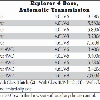2wd mode on the 95/96 should be used when there are no slippery conditions. It is awesome because the transfer case solenoid, differential, and even the 1/2shafts aren't being stressed. It actually disconnects one front axle and acts like a RWD car. Many F150s to this day have a similar mode and hardware.
Auto is great for snowy/low traction conditions, clutch engages based on rear wheel spin. Later models have this mode instead of 2wd above. The center position is 4HI, which is the clutch engaged at 100%. Only for slippery conditions or offroad.
4wd low is when you really get stuck, but like others say it is good to exercise it a few times a year, because there is electromechanical action that could seize or have issues if never used. You should never drive with it on dry pavement, just switch in and drive a few feet in a straight line to exercise it.










